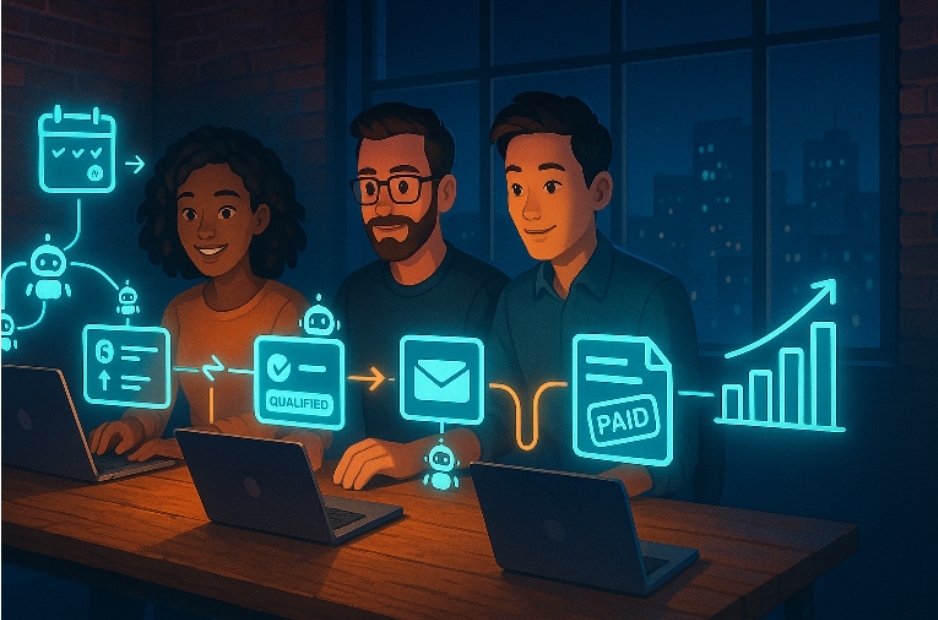If you run a three-person startup, your to-do list often grows faster than your MRR. According to a 2025 Zapier survey, founders now spend 61% of their week on repetitive “glue work” instead of strategy or product development. Hitting that capacity wall is painful—and totally solvable with autonomous AI agents.
Below is a step-by-step playbook to help you build–or buy–agents that handle growth and ops work while you sleep.
Why Small Teams Hit a Capacity Wall
Two-sentence reality check. Time is finite, but the channels you must cover—email, social, support, finance—multiply weekly. Without automation, growth stalls.
Top time sinks for lean teams.
- Manually scheduling social content
- Copy-pasting leads into a CRM
- Triaging “where’s my order?” tickets
- Chasing overdue invoices
- Compiling metrics for investors
Each task feels trivial. Together, they swallow entire quarters.
AI Agents 101: Beyond Chatbots & RPA
What Makes an Agent Autonomous?
A chatbot answers questions; an agent acts. Gartner defines an autonomous agent as a software entity that “perceives, decides, and executes with minimal human oversight.”
Core Building Blocks in Plain English
- Perception – reads an email, Slack ping, or API event
- Memory – stores state in a vector database or cache
- Decision engine – LLM + rules that choose the following action
- Action layer – hits APIs, updates a sheet, or sends a reply
- Feedback loop – logs results, learns from errors
Think of it as hiring an intern who never sleeps and documents everything.
5 Quick-Win Use Cases You Can Launch This Week
- Cold-Email Drip & Personalization
Pull prospect data, draft context-rich messages, and auto-sequence follow-ups. - Social-Media Scheduling + Auto-Engage
Generate posts, schedule across platforms, like & reply to comments inline. - Lead-Qual Triage & CRM Enrichment
Score inbound forms, enrich them via LinkedIn & Clearbit, and assign to the pipeline. - Tier-1 Support Resolution
Classify tickets, answer FAQ-level queries, and escalate edge cases. - Invoice & Expense Reconciliation
Read PDFs or email receipts, match them against the PO, and nudge late payers.
McKinsey’s 2024 “Small-Biz Automation Index” shows that these five workflows consume 32% of an average founder’s week—prime real estate for agents.
The Minimal Tech Stack
- LLM “brain” – OpenAI GPT-4o, Anthropic Claude 3, or open-source Mixtral.
- Tool/Action layer – LangChain Plugins, Microsoft Semantic Kernels, or Zapier Actions.
- Data store & memory – Postgres + pgvector, Pinecone, or Weaviate.
- Orchestrator/scheduler – Temporal, Airflow, or a simple cron job.
Pro tip: Start serverless to avoid DevOps drag; upgrade only when latency or cost demands.
The Code (20-Line Python Demo)
# minimal_agent.py
import os, httpx, json
from datetime import datetime
OPENAI_KEY = os.getenv(“OPENAI_API_KEY”)
def perceive():
“”” Fetch the latest unanswered support email.”””
resp = httpx.get(“https://api.mailhooks.io/unanswered?limit=1”)
return resp.json()[0]
def decide(context):
prompt = (
“You are a support agent. Craft a polite, accurate reply to:\n”
f”{context[‘body’]}\n###\n”
)
data = {“model”: “gpt-4o”,
“messages”: [{“role”: “user”, “content”: prompt}]}
resp = httpx.post(
“https://api.openai.com/v1/chat/completions”,
headers={“Authorization”: f”Bearer {OPENAI_KEY}”},
json=data,
timeout=30,
)
return resp.json()[“choices”][0][“message”][“content”]
def act(email_id, reply):
httpx.post(
f”https://api.mailhooks.io/reply/{email_id}”,
json={“body”: reply, “sent_at”: datetime.utcnow().isoformat()}
)
if __name__ == “__main__”:
ticket = perceive()
response = decide(ticket)
act(ticket[“id”], response)
Putting It All Together
Before shipping, walk through this 48-hour pilot checklist:
- Map one workflow end-to-end on a whiteboard.
- List every trigger, API, and permission needed.
- Spin up a development key for each SaaS you’ll interact with.
- Create a prompt library (system + context + examples).
- Add robust error handling and logging.
- Launch in shadow mode—agent writes drafts, humans approve.
- Flip the switch once accuracy exceeds 90%.
Need a ready-made AI agent that bundles memory, orchestration, and guardrails? Plug it in at step 4 and skip weeks of wiring.
Measuring Success: KPIs & Benchmarks
| KPI | Baseline (Manual) | Agent-Driven Target | 90-Day Result* |
| Avg. response time | 3 h | < 10 min | 8 min |
| Cost per ticket | $4.10 | < $1.50 | $1.14 |
| Leads qualified / week | 45 | 120 | 132 |
| Founder hours saved | — | — | 22 h/week |
| CSAT (1-5) | 3.8 | > 4.3 | 4.5 |
Pilot data from a 2025 cohort of eight e-commerce micro-brands (Gartner SMB Pulse).
Risk & Governance You Can’t Ignore
- Model drift – retrain prompts monthly; monitor hallucination rates.
- Rate limits & retries – queue calls to avoid 429 storms.
- Human-in-the-loop review – mandatory for payments, refunds, or anything legal.
- Audit trails – log prompts, decisions, and external calls for compliance.
- PII handling – mask emails/phone numbers before passing to LLMs.
Remember: convenience means nothing if you compromise trust.
Conclusion: Next Steps For Your First Autonomous Workflow
Start tiny—one agent, one task, one measurable KPI. Iterate fast, document lessons, then clone success across departments. The difference between a hustle and a scalable business is often the mundane work you no longer have to do.
Ready to reclaim your calendar? Spin up your first agent tonight and let tomorrow’s inbox sort itself.
